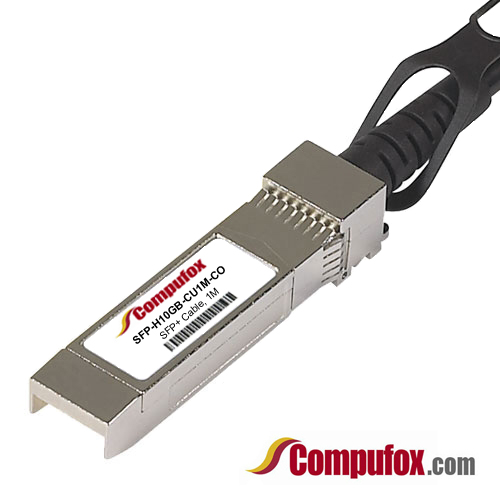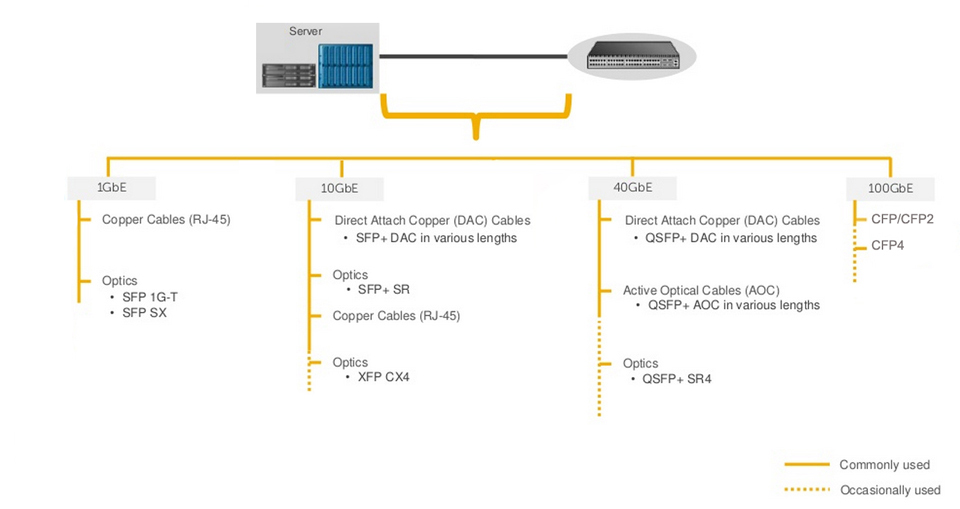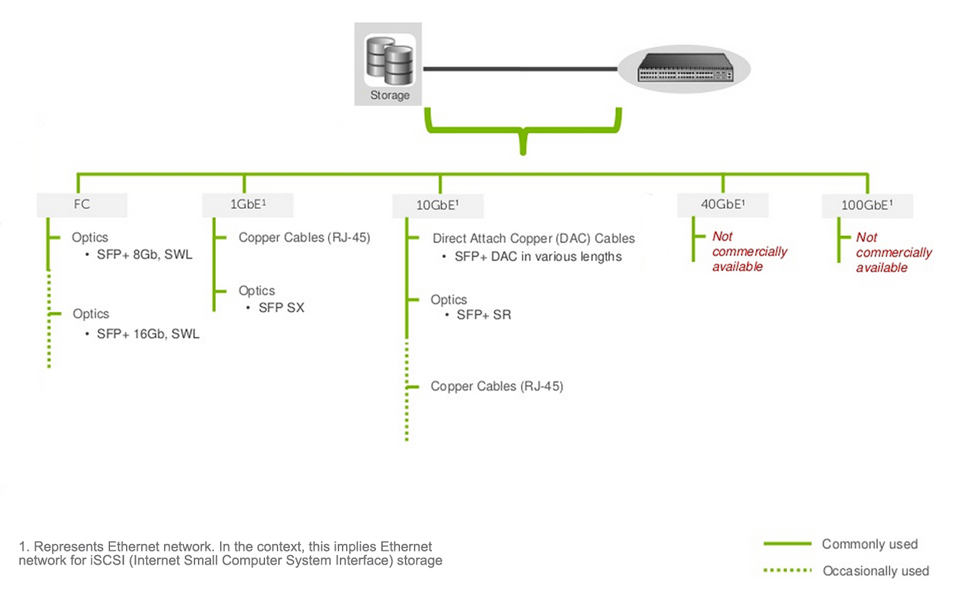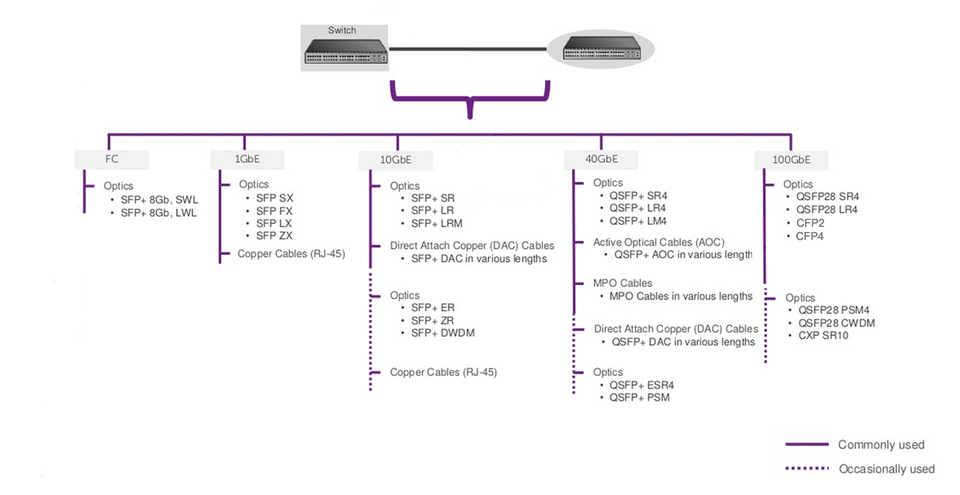What You Will Learn
This document describes how the Cisco® 40-Gbps QSFP BiDi transceiver reduces overall costs and installation time for customers migrating data center aggregation links to 40-Gbps connections.
As a result of data center consolidation, server virtualization, and new applications that require higher data transport rates, the data center network is shifting to 10 Gbps at the access layer and 40 Gbps at the aggregation layer. A broad portfolio of high-performance and high-density 10- and 40-Gbps Cisco Nexus® Family switches is available at attractive prices for this transition. However, to support 40-Gbps connectivity, data center architects are challenged by the need for a major upgrade of the cabling infrastructure, which can be too expensive or disruptive to allow data centers to quickly adopt and migrate to the 40-Gbps technology.
Cisco solves this problem with innovative 40-Gbps Quad Small Form-Factor Pluggable (QSFP) bidirectional (BiDi) technology that allows reuse of existing 10-Gbps fiber infrastructure for 40-Gbps connections.
Challenges with Existing 40-Gbps Transceivers
Standard short-reach (SR) 10- and 40-Gbps transceivers use fundamentally different connectivity formats, requiring fiber cabling infrastructure to be redesigned and replaced. 10-Gbps SR transceivers operate over dual-fiber multimode fiber (MMF) with LC connectors, and 40-Gbps SR protocols, such as SR4 and CSR4, operate over MMF ribbon with MPO connectors. As a result, 40-Gbps MPO-based SR4 transceivers cannot reuse aggregation fiber infrastructure built for 10-Gbps connectivity.
Connector type is not the only concern. Whereas 10-Gbps SR transceivers require 2 fiber strands per 10-Gbps link, 40-Gbps SR4 and CSR4 transceivers require a theoretical minimum of 8 fiber strands, and often 12 fiber strands in practice. The reason for this requirement is that 40-Gbps SR4 and CSR4 use 4 parallel fiber pairs (8 fiber strands) at 10-Gbps each for a total of 40-Gbps full duplex, as shown in Figure 1. However, both use MPO-12 connectors, which terminate 12-fiber ribbons. As a result, 4 fiber strands in each connection are unused and wasted.
To economize trunk fiber in a structured cabling environment, a 2 x 3 MPO fiber conversion module could combine three SR4 links onto two 12-fiber ribbon cables. But even then the 40-Gbps SR4 trunk still uses 8 fiber strands per link compared to 2 fiber strands in the case of 10-Gbps SR.
At best, the connector change and increased fiber density needed for SR4 require a significant cable plant upgrade, making it expensive and disruptive for customers to migrate from 10-Gbps connectivity to 40‑Gbps connectivity in their existing data centers.
Figure 1. Concept of Existing 40-Gbps Transceivers: Of the 12 Fiber Strands Terminated by MPO-12 Connectors, 8 Fiber Strands (4 Fiber Pairs) Carry Traffic and 4 Are Unused
Solution with Cisco 40-Gbps QSFP BiDi Transceiver
The Cisco QSFP BiDi transceiver, shown in Figure 2, transmits full-duplex 40-Gbps traffic over one dual-fiber LC-connector OM3 or OM4 MMF cable. It provides the capability to reuse 10-Gbps fiber infrastructure. In other words, it enables data center operators to upgrade to 40-Gbps connectivity without making any changes to the previous 10-Gbps fiber cable plant.
Figure 2. Cisco QSFP BiDi Transceiver (QSFP-40G-SR-BD)
The Cisco QSFP BiDi transceiver has two 20-Gbps channels, each transmitted and received simultaneously over two wavelengths on a single MMF strand. The result is an aggregated duplex 40-Gbps link over a MMF duplex LC-terminated fiber cable. The connection can reach 100 meters on OM3 MMF or 150 meters on OM4 MMF, which is the same as 40-Gbps SR4. Figure 3 shows the technology concept of the Cisco QSFP BiDi transceiver.
Most Cisco switching and routing products that support 40 Gigabit Ethernet interfaces support the Cisco QSFP BiDi transceiver. For a complete list of supporting products, refer to the Cisco 40 Gigabit Optical Transceiver product page at http://www.cisco.com/en/US/products/ps11708/index.html.
Figure 3. Concept of Cisco QSFP BiDi Transceiver
Savings with Cisco QSFP BiDi When Migrating from 10 Gbps to 40 Gbps
This section presents two case studies that demonstrate the savings achieved by using Cisco QSFP BiDi technology for 40-Gbps connectivity in data center networks. The case studies show how Cisco QSFP BiDi technology can remove the cost barriers for migrating and expanding the existing 10-Gbps cabling footprint to 40-Gbps infrastructure to provide the higher data rate in the data center network.
Case Study 1: 288 x 40-Gbps Connections with Unstructured Cabling
In an unstructured cabling system, devices are connected directly with fiber cables. This direct-attachment design can be used to connect devices within short distances in a data center network. As shown in Figure 4, direct connection between two 40-Gbps devices can be provided by MMF cables with either QSFP SR4 or QSFP BiDi transceivers at two ends.
Figure 4. Direct 40-Gbps Connections
The QSFP SR4 transceiver uses MPO-12 connectors, whereas Cisco QSFP BiDi uses LC connectors. Existing 10-Gbps connections commonly are MMF cables with LC connectors. Therefore, with QSFP SR4 transceivers, none of the existing 10-Gbps MMF cables can be reused because the connector types are different. Cisco QSFP BiDi allows cable reuse, resulting in zero-cost cabling migration from direct 10-Gbps connections to direct 40-Gbps connections.
Table 1 summarizes the costs and savings of migration and new deployment of 288 direct connections. To migrate the existing 288 10-Gbps connections to 40-Gbps connections, Cisco QSFP BiDi does not require any new spending on cables. Therefore, in comparison to QSFP SR4 transceivers, Cisco QSFP BiDi transceivers reduce costs by 100 percent and provide savings of up to US$290 per 40-Gbps port.
Table 1. Fiber Infrastructure Savings for 10-Gbps to 40-Gbps Direct-Cabling Migration and New 40-Gbps Deployment
|
Fiber Cable Infrastructure Cost and Savings with BiDi* (US$)
|
30m
|
60m
|
100m
|
|
288 LC-connector dual-fiber MMF cables for Cisco BiDi
|
$7,884
|
$12,966
|
$19,647
|
|
288 MPO-connector ribbon-fiber MMF cables for SR4
|
$32,058
|
$53,562
|
$83,412
|
|
10-Gbps to 40-Gbps migration
|
Total savings (US$)
|
$32,058
|
$53,562
|
$83,412
|
|
Per port savings (US$)
|
$111
|
$186
|
$290
|
|
Savings (percent)
|
100%
|
100%
|
100%
|
|
New 40-Gbps deployment
|
Total savings (US$)
|
$24,174
|
$40,599
|
$63,765
|
|
Per-port savings (US$)
|
$84
|
$141
|
$221
|
|
Savings (percent)
|
75%
|
76%
|
77%
|
* This example is based on real-world cable cost estimates. The transceiver cost is not included.
For the case in which 288 new direct 40-Gbps connections are needed in addition to the existing cabling infrastructure for a data center migration or expansion, the savings for 288 new connections using Cisco QSFP BiDi instead of QSFP SR4 transceivers is as high as 77 percent and US$221 per 40-Gbps port. These numbers do not take into account the installation costs. Adding installation costs could easily double the SR4 deployment costs.
Case Study 2: 384 x 40-Gbps Connections with Structured Cabling
A structured cabling system is commonly deployed in data center networks to provide flexible and scalable cabling infrastructure. Structured cabling uses short patch cords to attach devices to a patch panel and then runs fiber trunks either to consolidate the cables in a central location for additional connectivity or to direct them to another patch panel to which the remote devices are attached. Figure 5 shows a simple example of a 10-Gbps structured cabling design.
Figure 5. Simple Example of 10-Gbps Structured Cabling
For migration of a data center with a structured 10-Gbps cabling system, Cisco QSFP BiDi technology allows you to repurpose the existing cabling system - including the patch cables, patch panels with MTP/MPO LC modules, and fiber trunks - for 40-Gbps connectivity. In contrast, QSFP SR4 transceivers require new patch cables and patch panels because the connector types differ and the size of the fiber trunk needs to be quadrupled.
This case study examines a simple nonblocking two-tier fabric design (Figure 6) that provides 1536 10-Gbps edge ports on its leaf layer. Its spine layer is composed of two Cisco Nexus 9508 Switches, and its leaf layer consists of 32 Cisco Nexus 9396PX Switches, each with six 40-Gbps links to every spine Cisco Nexus 9508. There are 384 40-Gbps links total between the leaf and spine layers.
Figure 6. Two-Tier Network Example
If 384 x 10-Gbps connections are to be reused to construct this network, no additional spending on cabling will be needed if Cisco QSFP BiDi transceivers are used for all the 40-Gbps links. This scenario thus offers a 100 percent cost savings compared to the cost of reconstructing the cabling system using QSFP SR4 transceivers, including the cost of new patch cables, new patch panels, and expansion of the current fiber trunk.
If the cabling for this network is a new (greenfield) deployment or an expansion of an existing cabling system, the 384 x 40-Gbps connections can be built by using MMF cables and either QSFP SR4 transceivers or Cisco QSFP BiDi transceivers. Figures 7 and 8 show design examples for each option. Table 2 compares real-world cost estimates for these two designs. The design with Cisco QSFP BiDi offers 77 percent savings over that with QSFP SR4 transceivers, which is equivalent to a savings of US$2077 per 40-Gbps connection.
Figure 7. Structured 40-Gbps Cabling with QSFP SR4 Transceivers
Table 2. Structured 40-Gbps Cable Infrastructure Cost Comparison
|
Structured 40-Gbps Cable Infrastructure Cost Savings with BiDi Technology (US$)
|
|
|
Unit Price* (US$)
|
Quantity
|
Total (US$)
|
|
90m 12-fiber MPO-MPO trunk cable (3 SR links per 2 cables)
|
$1844
|
384 x (2/3)
|
$472,064
|
|
12-fiber MPO-MPO 2x3 conversion module (3 SR links per module, both ends)
|
$1200
|
384 x (1/3) X 2
|
$307,200
|
|
12-fiber MPO jumper (1 per link, both ends)
|
$340
|
384 x 2
|
$261,120
|
|
SR total
|
|
|
$1,040,384
|
|
90m 12-fiber MPO-MPO trunk cable (6 BiDi links per cable)
|
$1844
|
384 x (1/6)
|
$118,016
|
|
12-fiber MPO-LC trunk module (6 BiDi links per module, both ends)
|
$525
|
384 x (1/6)
|
$67,200
|
|
12-fiber LC jumper (1 per link, both ends)
|
$75
|
384 x 2
|
$57,600
|
|
BiDi total
|
|
|
$242,816
|
|
Total savings
|
|
|
$797,568
|
|
Percentage savings
|
|
|
77%
|
*Based on manufacturer’s list price
Figure 8. Structured 40-Gbps Cabling with Cisco QSFP BiDi Transceivers
Conclusion
Cisco QSFP BiDi technology removes 40-Gbps cabling cost barriers for migration from 10-Gbps to 40-Gbps connectivity in data center networks. Cisco QSFP BiDi transceivers provide 40-Gbps connectivity with immense savings and simplicity compared to other 40-Gbps QSFP transceivers. The Cisco QSFP BiDi transceiver allows organizations to migrate the existing 10-Gbps cabling infrastructure to 40 Gbps at no cost and to expand the infrastructure with low capital investment. Together with Cisco Nexus 9000 Series Switches, which introduce attractive pricing for networking devices, Cisco QSFP BiDi technology provides a cost-effective solution for migration from 10-Gbps to 40-Gbps infrastructure.
Read more »








